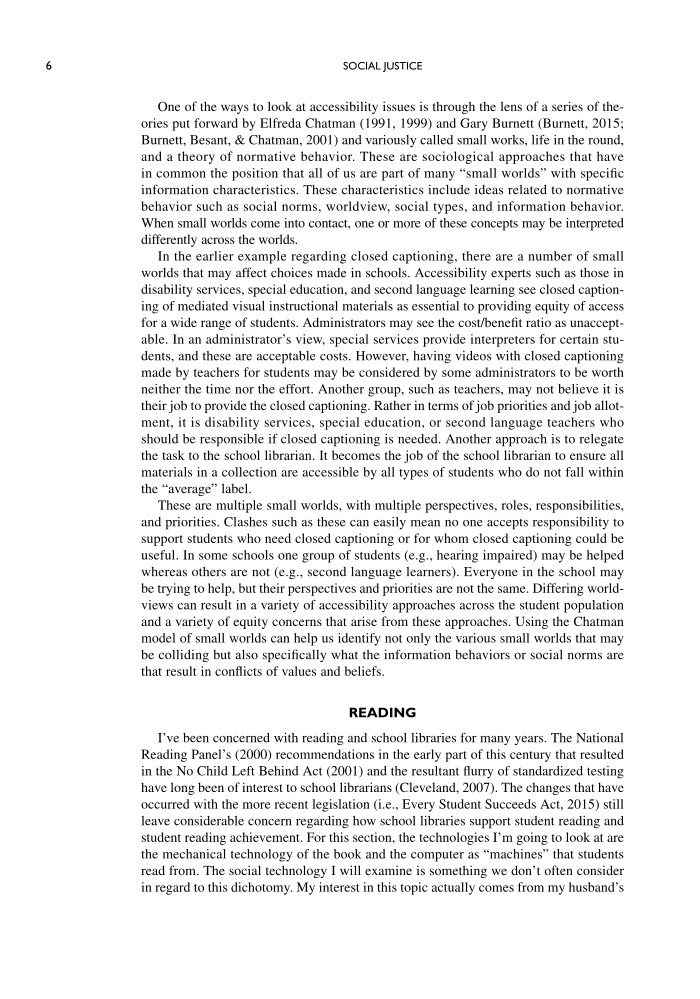One of the ways to look at accessibility issues is through the lens of a series of the- ories put forward by Elfreda Chatman (1991, 1999) and Gary Burnett (Burnett, 2015 Burnett, Besant, & Chatman, 2001) and variously called small works, life in the round, and a theory of normative behavior. These are sociological approaches that have in common the position that all of us are part of many “small worlds” with specific information characteristics. These characteristics include ideas related to normative behavior such as social norms, worldview, social types, and information behavior. When small worlds come into contact, one or more of these concepts may be interpreted differently across the worlds. In the earlier example regarding closed captioning, there are a number of small worlds that may affect choices made in schools. Accessibility experts such as those in disability services, special education, and second language learning see closed caption- ing of mediated visual instructional materials as essential to providing equity of access for a wide range of students. Administrators may see the cost/benefit ratio as unaccept- able. In an administrator’s view, special services provide interpreters for certain stu- dents, and these are acceptable costs. However, having videos with closed captioning made by teachers for students may be considered by some administrators to be worth neither the time nor the effort. Another group, such as teachers, may not believe it is their job to provide the closed captioning. Rather in terms of job priorities and job allot- ment, it is disability services, special education, or second language teachers who should be responsible if closed captioning is needed. Another approach is to relegate the task to the school librarian. It becomes the job of the school librarian to ensure all materials in a collection are accessible by all types of students who do not fall within the “average” label. These are multiple small worlds, with multiple perspectives, roles, responsibilities, and priorities. Clashes such as these can easily mean no one accepts responsibility to support students who need closed captioning or for whom closed captioning could be useful. In some schools one group of students (e.g., hearing impaired) may be helped whereas others are not (e.g., second language learners). Everyone in the school may be trying to help, but their perspectives and priorities are not the same. Differing world- views can result in a variety of accessibility approaches across the student population and a variety of equity concerns that arise from these approaches. Using the Chatman model of small worlds can help us identify not only the various small worlds that may be colliding but also specifically what the information behaviors or social norms are that result in conflicts of values and beliefs. READING I’ve been concerned with reading and school libraries for many years. The National Reading Panel’s (2000) recommendations in the early part of this century that resulted in the No Child Left Behind Act (2001) and the resultant flurry of standardized testing have long been of interest to school librarians (Cleveland, 2007). The changes that have occurred with the more recent legislation (i.e., Every Student Succeeds Act, 2015) still leave considerable concern regarding how school libraries support student reading and student reading achievement. For this section, the technologies I’m going to look at are the mechanical technology of the book and the computer as “machines” that students read from. The social technology I will examine is something we don’t often consider in regard to this dichotomy. My interest in this topic actually comes from my husband’s SOCIAL JUSTICE 6
Document Details My Account Print multiple pages
Print
You have printed 0 times in the last 24 hours.
Your print count will reset on at .
You may print 0 more time(s) before then.
You may print a maximum of 0 pages at a time.





































































































































































































